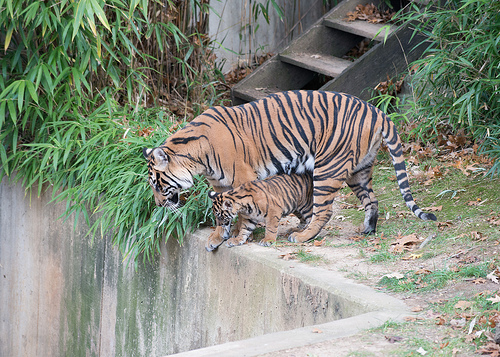I have been to see the National Zoo’s Sumatran tiger cubs, and I have important news: They are adorable.
The twin cubs, a boy and a girl, were on display for the first time yesterday at the zoo here in Washington, D.C. A little after 10 a.m., keepers opened the metal door at the bottom of a short concrete set of stairs. First the mother’s round face appeared in the stairwell, then a tiny pair of ears, then both cubs.
An audience of 70 or 80 people, armed with cameras ranging from smartphone to telescope-sized, watched as the two cubs wandered, sniffing at dry leaves, trying out the stairs to the higher levels of the sloping exhibit. The lion roared from next door, a few dozen feet away but out of sight. One of the cubs jumped on a black piece of wood. One stood on its hind legs, stretching to reach up one of the enclosure’s mighty oaks with its front claws.
As they got more comfortable, they turned toward important kitten activities like scampering and pouncing. Sometimes one would lie on its back to bat at the other with its oversized paws. Solid kitten business.
Sumatran tigers in the wild are, as far as I can tell, screwed. On the IUCN Red List of Threatened Species, they’re Critically Endangered, which is one notch above Extinct in the Wild. There are only a few hundred outside of zoos, scattered across a dozen separate areas on the Indonesian island of Sumatra. Tigers are all the same species, but there are nine subspecies. Or there used to be; three have gone extinct and one other is only in zoos. The extinct subspecies include the Sumatran tiger’s Indonesian cousins, the Bali tiger and the Javan tiger.
The main threats to Sumatran tigers are habitat destruction and hunting. In other words, people. Shrinking their habitat not only gives them less space to live in —a tiger needs a lot of space—it also puts them in contact with exciting new foods, like cows, and eating livestock makes it more likely they’ll get killed. Those pressures aren’t going away.
The baby tigers are a little over three months old; they were born August 5. Zoos used to just let animals mate with whatever, but they’ve gotten more careful; now they have Species Survival Plans and experts manage their mating to keep them from getting inbred. Tigers are also one of only a few species that have a Global Species Management Plan, in which zoos on multiple continents coordinate; last year the National Zoo sent a male to live in Yokohama, Japan, because there was a young female there who he wasn’t related to and might be persuaded to mate with.
As of 2012, according to the Species Survival Plan, all 74 Sumatran tigers being managed in North America were descended from the same 16 founders. But apparently the cubs’ parents were far enough apart on the captive tiger family tree to make it worth letting them mate. The mother, Damai, grew up in San Diego. The father, Kavi, was trucked up from Atlanta last year.
A Sumatran tiger in the wild would have her 2 or 3 cubs in private. That was not how it went for Damai. Fans have been watching the little ones for months on the zoo’s Tiger Cam.
And, yesterday, fans were there to see them in person.
The carousel went around and around a few feet from the Great Cats exhibit, playing its mad tunes. The cubs raced in a circle, sprinting up a slight hill with their seesawing gait, then squeezing between a stand of greenery and the exhibit’s concrete wall, before re-emerging with a crash of bamboo to pounce on their mother. Crashing and pouncing and falling off of things were featured activities yesterday. They stayed outside for an hour and 40 minutes, much longer than planned, charming their public on the sunny fall morning. (Watch my video.)
The zoo’s species survival plans are about maintaining genetic diversity in the zoos, not the wild. There’s no plan to send these soft zoo babies off to live in the Sumatran woods.
Some kind of reintroduction could theoretically happen one day, if humans stopped messing up their environment. Really, they’re here to entertain, as zoo animals have always done, and to be ambassadors for their species. They frolic so people like me will look up Sumatran tigers and find out just badly they’re doing in the wild.

KITTIES! Thanks for the nice post, Helen. Very sad about their status in the wild. And still exciting to be able to see them in zoos. I cannot wait.
Your video is also very cute. Their mother is so playful, too! But FYI: the “They frolic” link just takes you to the YouTube homepage.
Thank you! I think it’s fixed now.